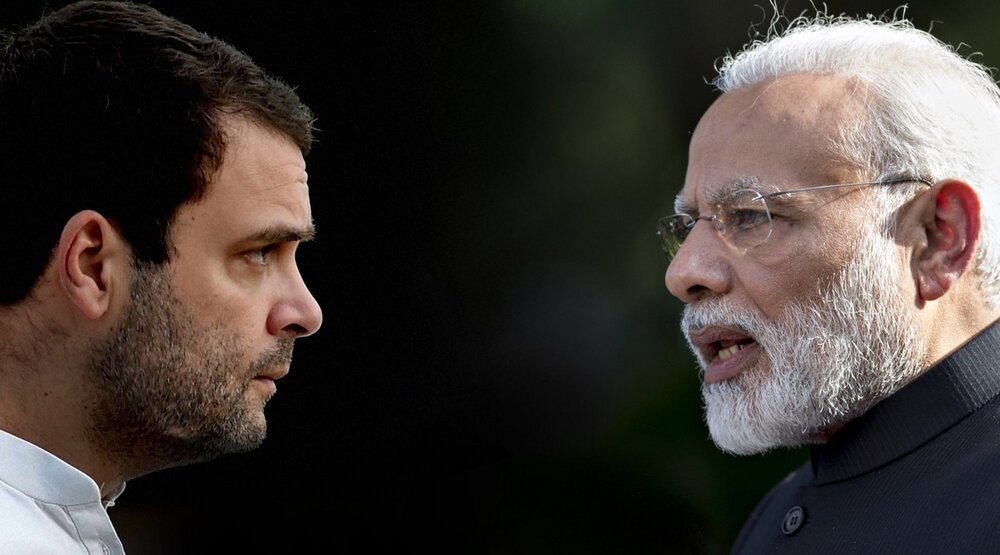Battle lines drawn for India elections; Modi and Gandhi main challengers

TEHRAN _ Battle lines are drawn and countdown has virtually begun for the biggest electoral showdown on the earth – the elections for India’s parliament – scheduled in April.
All major political parties in India have kicked off their campaign trial ahead of elections, with Bharatiya Janata Party (BJP) seeking to retain power and Congress looking to stage a strong comeback.
On Sunday, India’s election commission announced dates for the election that will see almost 900 million voters exercise their franchise at more than a million polling booths, which happens to the world’s largest democratic exercise.
The commission announced that the election will be held in seven phases on April 11, 18, 23, 29 and May 6, 12 and 19. The counting of votes will be held on May 23, followed by announcement of results.
Assembly elections will also be held simultaneously to four states – Andhra Pradesh, Sikkim, Arunachal Pradesh and Odisha. Jammu and Kashmir, the restive northern state of India, where a coalition government collapsed in June 2018, will not have assembly election, but will go for parliament poll.
The commission has faced heat from opposition parties for using electronic voting machines (EVMs), which many believe is prone to poll fraud and irregularities.
Too allay the fears of voters and observers, the commission said the voter-verifiable paper audit trail (VVPAT) system will be used in all polling stations. It is a device attached to an EVM and prints a small paper slip carrying the symbol, name and serial number of the candidate the voter votes for.
This system, authorities say, will help in verification process later and prevent allegations of fraud.
A total of 543 parliament seats are up for grabs in this election to Lok Sabha, India's lower house of parliament, which ultimately decides which party is eligible to form the government in New Delhi.
The incumbent Prime Minister Narendra Modi is running again for the top post, and he faces strong opposition in the form of Congress president Rahul Gandhi, the scion of India’s famed Gandhi family.
Although many political parties and powerful regional politicians are also in the fray, these two leaders are the main protagonists to represent more than 1.3 billion people.
While some analysts have given right-wing BJP a slight edge over Congress because of the hardcore Hindu narrative peddled by the party leaders to woo majority Hindu voters, some analysts see Gandhi putting up a tough challenge to BJP.
The recent military escalation between India and its arch-rival Pakistan in the aftermath of a deadly attack in Indian-controlled Kashmir has become an important, emotive poll issue for the ruling party, as Modi seeks to project his ‘heroic image’ as the mastermind of ‘surgical strikes’.
However, the election commission has asked political parties not to use images of the country's armed forces in their campaign posters and other advertising material during the general election.
In a notice published on its website on Saturday, the commission said political parties must refrain from using photographs of defence personnel in advertisements or their election campaign propaganda as the armed forces are "apolitical and neutral stakeholders in a modern democracy".
Moreover, Modi has come under criticism for poor economic policies and lack of jobs in the country.
Some latest opinion polls have pointed to diminishing support for Modi-led BJP over job and economy, and hinted that the party may fall short of the absolute majority of 272 seats to form the next government without any external support.
Gandhi, who failed to impress political pundits in India for many years, has shown signs of political maturity and seriousness over the past one year, which was evident from party’s sweep in elections to three key states in December, a big setback for the BJP.
He has been scathing in his criticism of Modi's economic policies, his failure to help impoverished farmers and to create jobs for unemployed youth.
However, his party is not seen as strong enough to clinch the election on its own. So, it has entered into alliances with a number of regional parties across India, all of them having a common agenda to prevent BJP from coming back to power.
While acknowledging that national security issues could outdo economic issues in impacting voter behaviour in the elections, the latest HSBC Global Research report says a wave of new coalitions suggests “non-BJP parties are less fragmented today, making it a tough contest for the incumbent.”
The factors that will shape 2019 results, according to the report, are the geopolitical issues that will dominate the next few weeks.
“It is the BJP that faces anti-incumbency sentiment. Whether or not the youth will show up to vote with as much enthusiasm as before, and vote for the BJP as they did last time, cannot be ascertained,” the report notes. “Growth in some pockets of the economy is slowing, though not to worrisome levels, in our view. And the non-BJP votes may not be as fragmented as before,” it says.
It further says the recent surveys show the gap between Modi and Gandhi’s popularity ratings narrowing down and that voters’ preference for Gandhi as an alternative for PM’s post among opposition leaders is also on the rise.
So, will the Gandhi scion have the better of Modi? Or will Modi find the going easy. We shall know on May 23.
